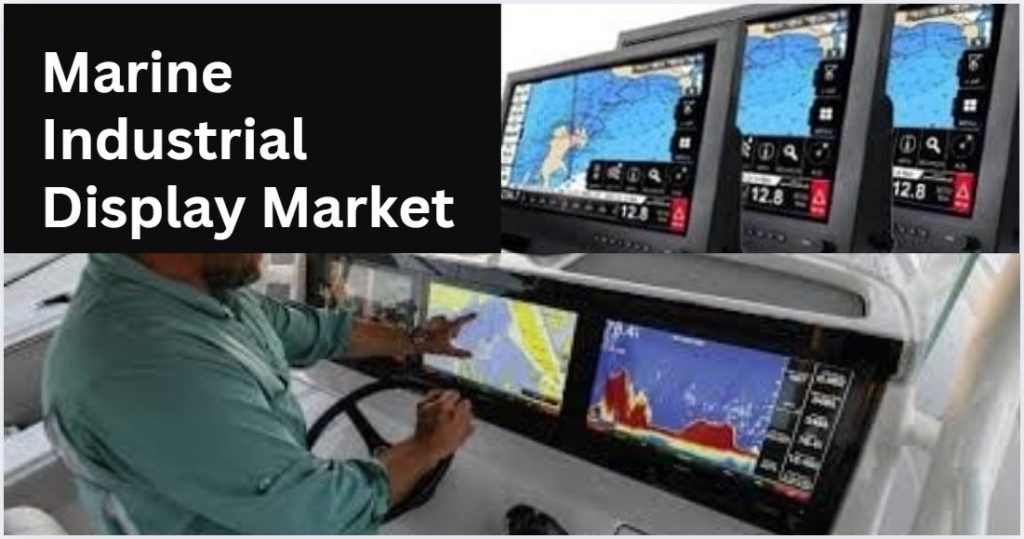
Market Overview
The Marine Industrial Display Market was valued at USD 5,168.20 million in 2024 and is projected to reach USD 8,237.32 million by 2032, growing at a CAGR of 6% during the forecast period. This growth underscores the increasing reliance on robust display technologies in maritime applications. Whether on commercial ships, naval vessels, or offshore platforms, high-performance displays are now vital for communication, navigation, and operations.
The market’s importance is deeply rooted in its role in enhancing operational safety, efficiency, and decision-making in extreme marine environments. As maritime logistics and offshore activities scale up globally, the demand for displays that can withstand vibration, moisture, temperature variations, and salt corrosion continues to rise. Moreover, the integration of real-time data visualization and control systems has transformed marine operations, making industrial displays indispensable across verticals.
The global context favors this growth. Rising investments in smart ship technologies, the expansion of offshore drilling, and an increasing number of marine-based renewable energy projects drive the demand for durable and advanced marine industrial displays. Furthermore, naval modernization programs and marine transportation infrastructure improvements across multiple geographies contribute to the market’s upward momentum. As industries become more data-driven and digitally integrated, industrial displays in marine environments will play an increasingly central role in managing equipment, navigating safely, and enhancing operational transparency.
Download Sample Report: https://www.credenceresearch.com/report/marine-industrial-display-market
Market Drivers
Technological Advancements in Display Systems
Cutting-edge improvements in display technologies, such as OLED, LED, and high-resolution LCD panels, are revolutionizing the marine sector. These displays offer improved brightness, contrast ratios, and power efficiency, which are critical in marine environments where visibility can be limited. Manufacturers are now offering sunlight-readable screens with enhanced durability, allowing for clearer data display in outdoor conditions. As marine environments require displays that function flawlessly amid harsh settings, innovation becomes a fundamental growth driver.
Expansion of Offshore Oil & Gas Activities
With offshore exploration gaining momentum globally, especially in deep-sea oil and gas fields, marine industrial displays are witnessing increased application. Displays are essential for real-time data monitoring, control panels, and communication equipment on offshore platforms. These harsh environments demand resilient systems that offer both functionality and endurance. The display systems integrated into drilling and safety operations have become crucial, pushing demand higher in tandem with global energy needs.
Growing Naval and Defense Upgrades
Several countries are investing heavily in naval modernization to reinforce their maritime capabilities. Advanced vessels are equipped with smart control rooms and high-precision navigation systems that rely on marine-grade industrial displays. These are used in radar systems, command centers, and surveillance setups. As defense budgets expand, especially in the Asia-Pacific and Middle East regions, demand for rugged, high-performance marine displays continues to grow.
Rise in Marine Transportation and Logistics
Marine logistics remains a backbone of global trade. As international shipping companies upgrade their fleets with automated systems and smart bridges, the requirement for high-clarity, touch-based, and rugged industrial displays grows. These displays aid in route tracking, system monitoring, and real-time communication, making them essential for modern marine transportation.
Market Challenges
Harsh Environmental Conditions
Marine environments present extreme conditions—humidity, salt, high vibration, and drastic temperature shifts—that can degrade display systems quickly. Ensuring long-term durability and consistent performance under such pressures requires significant R&D, increasing product development costs.
High Initial Cost of Implementation
Marine-grade industrial displays often come with a high price tag due to specialized components and rugged designs. For smaller operators and fleets, upfront costs can be a deterrent. Budget constraints may hinder widespread adoption, particularly in developing nations.
Regulatory Compliance and Standardization
Strict regulations surrounding marine equipment—including certifications like IEC 60945 or DNV-GL—pose a challenge for manufacturers. Products must meet these stringent guidelines, often leading to extended development cycles and testing phases before market launch.
Limited Retrofitting Flexibility
Retrofitting old ships and platforms with new digital systems, including industrial displays, can be complex and costly. Legacy infrastructure often lacks compatibility with modern display technology, making full system overhauls necessary. This discourages adoption, especially in older fleets.
Market Opportunity
Integration with AI and IoT Systems
Modern marine displays are increasingly being designed to interface with AI-powered analytics and IoT ecosystems. Displays can now provide predictive maintenance alerts and real-time diagnostics, transforming how marine operations are managed.
Expansion in Renewable Offshore Energy
With offshore wind farms and wave energy installations expanding, the need for real-time control and monitoring systems grows. Marine industrial displays play a pivotal role in control rooms and substations, creating new demand from the renewable energy vertical.
Growth of Autonomous Vessels
Autonomous and remotely operated vessels are on the rise. These ships require advanced display units for monitoring systems, both onboard and remotely. This trend is likely to propel investment into high-tech, multifunctional marine displays.
Customization and Modular Design Demand
Operators increasingly demand displays that can be customized to suit specific applications, from touch-sensitive interfaces to waterproof builds and modular setups. Companies offering these flexible options will find growth opportunities across emerging marine markets.
Market Segmentation
By Technology
- LED
- OLED
- LCD
- Others
By Panel Size
- Small (under 15 inches)
- Medium (15–24 inches)
- Large (above 24 inches)
By Application
- Commercial Marine
- Naval
- Offshore Platforms
- Others
By Verticals
- Manufacturing
- Energy & Power
- Oil & Gas
- Metals & Mining
- Transportation
By Region
North America
- U.S.
- Canada
- Mexico
Europe
- Germany
- France
- U.K.
- Italy
- Spain
- Rest of Europe
Asia Pacific
- China
- Japan
- India
- South Korea
- South-East Asia
- Rest of Asia Pacific
Latin America
- Brazil
- Argentina
- Rest of Latin America
Middle East & Africa
- GCC Countries
- South Africa
- Rest of the Middle East and Africa
Regional Analysis
North America
The U.S. leads the market with significant investments in naval modernization, autonomous shipping, and offshore energy projects. Canada and Mexico are also seeing growth in commercial marine applications. The presence of key manufacturers and technological advancements drive innovation in marine displays. Increasing defense budgets contribute to the expansion of the naval display segment. Adoption of AI-powered displays for enhanced maritime security is rising. Offshore wind energy projects in the U.S. are fueling demand for durable display systems.
Europe
Germany, France, and the U.K. drive market growth through strong naval R&D, smart port initiatives, and advanced shipbuilding capabilities. The EU’s focus on green shipping is influencing technology adoption. European shipyards are integrating state-of-the-art display systems in next-generation vessels. Regulatory policies favoring digitalization in maritime logistics boost display demand. Sustainable display solutions, including energy-efficient panels, are gaining traction in the region.
Asia-Pacific
China, Japan, and South Korea lead in shipbuilding and technological innovation. India’s expanding commercial maritime sector and South-East Asia’s rising offshore drilling projects contribute to growth. Increased government investments in marine infrastructure propel demand for advanced displays. Rising maritime trade volumes fuel the need for high-performance navigation displays.
Latin America
Brazil and Argentina are key markets due to increasing investments in port infrastructure and offshore oil exploration. Government policies supporting maritime trade boost demand. Latin American shipyards are modernizing fleets with next-generation display systems.
Middle East & Africa
GCC nations are investing in marine transportation, defense, and offshore energy projects. South Africa is witnessing growth in naval defense modernization. Oil-rich Gulf nations are investing in marine fleet expansion, increasing demand for rugged displays.
Top Companies
- Sharp NEC Display Solutions of America, Inc.
- Samsung
- Sony Corporation
- LG DISPLAY CO., LTD.
- Barco
- NEC Corporation
- Leyard Europe
- E Ink Holdings Inc.
- AUO Corporation
- DEEPSKY CORPORATION LTD
Future Outlook
- Demand for rugged and weather-resistant displays will increase as maritime operations expand into extreme environments, making durability a key requirement.
- OLED and MicroLED adoption will enhance display quality by offering improved brightness, energy efficiency, and longer lifespans for marine displays.
- Smart shipping and AI-powered dashboards will drive innovation through real-time data integration and automation, improving fleet management and operational efficiency.
- Growth in autonomous vessel technology will boost the market as self-navigating ships require advanced display interfaces for remote monitoring and control.
- Naval modernization programs will accelerate demand as defense organizations invest in high-performance, mission-critical display solutions for enhanced situational awareness.
- Investments in maritime cybersecurity will impact display solutions, making secure, encrypted interfaces essential to protect navigation and communication systems from cyber threats.
- Sustainable and energy-efficient displays will gain traction as eco-friendly solutions, such as low-power displays, align with global green shipping initiatives.
- Expansion in emerging markets will create new opportunities, driven by growing maritime trade and infrastructure development in Asia, Latin America, and Africa.
- Government funding for digital maritime solutions will rise as public and private sector investments support advancements in smart port technologies and digital navigation.
- Cross-industry collaborations will foster technological advancements through partnerships between marine, defense, and tech companies, driving next-generation display innovations.
Download Sample Report: https://www.credenceresearch.com/report/marine-industrial-display-market





